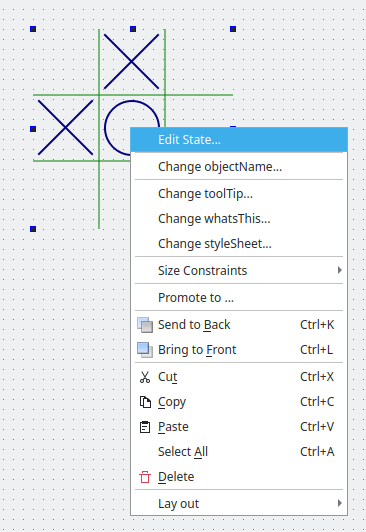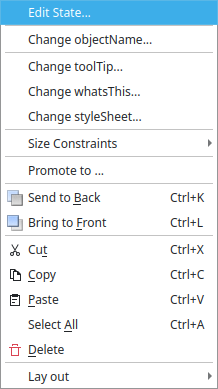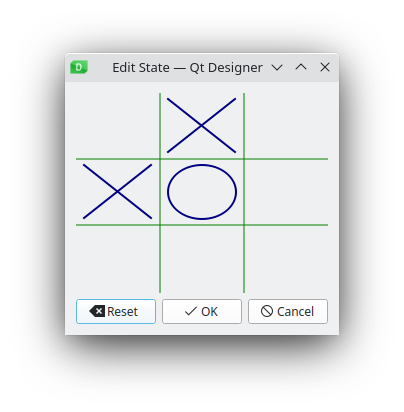Creating a custom widget plugin for Qt Designer and providing custom task menu entries that are associated with the plugin.
The Task Menu Extension example shows how to create a custom widget plugin for Qt Designer , and how to use the QDesignerTaskMenuExtension class to provide custom task menu entries associated with the plugin.

To provide a custom widget that can be used with Qt Designer , we need to supply a self-contained implementation. In this example we use a custom widget designed to show the task menu extension feature: The TicTacToe widget.
An extension is an object which modifies the behavior of Qt Designer 。 QDesignerTaskMenuExtension can provide custom task menu entries when a widget with this extension is selected.
There are four available types of extensions in Qt Designer :
You can use all the extensions following the same pattern as in this example, only replacing the respective extension base class. For more information, see the Qt Designer C++ 类 .
The Task Menu Extension example consists of five classes:
TicTacToe
is a custom widget that lets the user play the Tic-Tac-Toe game.
TicTacToePlugin
exposes the
TicTacToe
class to
Qt Designer
.
TicTacToeTaskMenuFactory
创建
TicTacToeTaskMenu
对象。
TicTacToeTaskMenu
provides the task menu extension, i.e the plugin's associated task menu entries.
TicTacToeDialog
lets the user modify the state of a Tic-Tac-Toe plugin loaded into
Qt Designer
.
The project file for custom widget plugins needs some additional information to ensure that they will work within Qt Designer . For example, custom widget plugins rely on components supplied with Qt Designer , and this must be specified in the project file that we use. We will first take a look at the plugin's project file.
Then we will continue by reviewing the
TicTacToePlugin
class, and take a look at the
TicTacToeTaskMenuFactory
and
TicTacToeTaskMenu
classes. Finally, we will review the
TicTacToeDialog
class before we take a quick look at the
TicTacToe
widget's class definition.
The project files need to state that a plugin linking to the Qt Designer libraries is to be built:
find_package(Qt6 REQUIRED COMPONENTS Core Designer Gui Widgets)
qt_add_plugin(taskmenuextension)
target_link_libraries(taskmenuextension PUBLIC
Qt::Core
Qt::Designer
Qt::Gui
Qt::Widgets
)
The following example shows how to add the header and source files of the widget:
target_sources(taskmenuextension PRIVATE
tictactoe.cpp tictactoe.h
tictactoedialog.cpp tictactoedialog.h
tictactoeplugin.cpp tictactoeplugin.h
tictactoetaskmenu.cpp tictactoetaskmenu.h
)
We provide an implementation of the plugin interface so that Qt Designer can use the custom widget. In this particular example we also provide implementations of the task menu extension and the extension factory as well as a dialog implementation.
It is important to ensure that the plugin is installed in a location that is searched by Qt Designer . We do this by specifying a target path for the project and adding it to the list of items to install:
set(INSTALL_EXAMPLEDIR "${QT6_INSTALL_PREFIX}/${QT6_INSTALL_PLUGINS}/designer")
install(TARGETS taskmenuextension
RUNTIME DESTINATION "${INSTALL_EXAMPLEDIR}"
BUNDLE DESTINATION "${INSTALL_EXAMPLEDIR}"
LIBRARY DESTINATION "${INSTALL_EXAMPLEDIR}"
)
The task menu extension is created as a library. It will be installed alongside the other
Qt Designer
plugins when the project is installed (using
ninja install
or an equivalent installation procedure).
For more information about plugins, see the 如何创建 Qt 插件 文档编制。
The following example shows how to link a plugin to the Qt Designer 库:
TEMPLATE = lib CONFIG += plugin QT += widgets designer
The following example shows how to add the header and source files of the widget:
HEADERS += tictactoe.h \
tictactoedialog.h \
tictactoeplugin.h \
tictactoetaskmenu.h
SOURCES += tictactoe.cpp \
tictactoedialog.cpp \
tictactoeplugin.cpp \
tictactoetaskmenu.cpp
OTHER_FILES += tictactoe.json
The following example shows how to install a plugin to the Qt Designer 's plugin path:
target.path = $$[QT_INSTALL_PLUGINS]/designer INSTALLS += target
The
TicTacToePlugin
class exposes
the
TicTacToe class to
Qt Designer
. Its definition is equivalent to the
自定义 Widget 插件
example's plugin class which is explained in detail. The only part of the class definition that is specific to this particular custom widget is the class name.
To ensure that Qt recognizes the widget as a plugin, export relevant information about the widget by adding the
Q_PLUGIN_METADATA()
宏:
#ifndef TICTACTOEPLUGIN_H #define TICTACTOEPLUGIN_H #include <QtUiPlugin/QDesignerCustomWidgetInterface> class QIcon; class QWidget; class TicTacToePlugin : public QObject, public QDesignerCustomWidgetInterface { Q_OBJECT Q_PLUGIN_METADATA(IID "org.qt-project.Qt.QDesignerCustomWidgetInterface") Q_INTERFACES(QDesignerCustomWidgetInterface) public: explicit TicTacToePlugin(QObject *parent = nullptr); QString name() const override; QString group() const override; QString toolTip() const override; QString whatsThis() const override; QString includeFile() const override; QIcon icon() const override; bool isContainer() const override; QWidget *createWidget(QWidget *parent) override; bool isInitialized() const override; void initialize(QDesignerFormEditorInterface *formEditor) override; QString domXml() const override; private: bool initialized = false; }; #endif
The plugin class provides
Qt Designer
with basic information about our plugin, such as its class name and its include file. Furthermore it knows how to create instances of the
TicTacToe
widget. TicTacToePlugin also defines the
initialize
() function which is called after the plugin is loaded into
Qt Designer
. The function's
QDesignerFormEditorInterface
parameter provides the plugin with a gateway to all of
Qt Designer
's API's.
The
TicTacToePlugin
class inherits from both
QObject
and
QDesignerCustomWidgetInterface
. It is important to remember, when using multiple inheritance, to ensure that all the interfaces (i.e. the classes that doesn't inherit
Q_OBJECT
) are made known to the meta object system using the
Q_INTERFACES
() macro. This enables
Qt Designer
要使用
qobject_cast
() to query for supported interfaces using nothing but a
QObject
指针。
The TicTacToePlugin class implementation is in most parts equivalent to the 自定义 Widget 插件 example's plugin class:
TicTacToePlugin::TicTacToePlugin(QObject *parent) : QObject(parent) { } QString TicTacToePlugin::name() const { return u"TicTacToe"_s; } QString TicTacToePlugin::group() const { return u"Display Widgets [Examples]"_s; } QString TicTacToePlugin::toolTip() const { return u"Tic Tac Toe Example, demonstrating class QDesignerTaskMenuExtension (C++)"_s; } QString TicTacToePlugin::whatsThis() const { return {}; } QString TicTacToePlugin::includeFile() const { return u"tictactoe.h"_s; } QIcon TicTacToePlugin::icon() const { return {}; } bool TicTacToePlugin::isContainer() const { return false; } QWidget *TicTacToePlugin::createWidget(QWidget *parent) { auto *ticTacToe = new TicTacToe(parent); ticTacToe->setState(u"-X-XO----"_s); return ticTacToe; } bool TicTacToePlugin::isInitialized() const { return initialized; }
The only function that differs significantly is the initialize() function:
void TicTacToePlugin::initialize(QDesignerFormEditorInterface *formEditor) {
The
initialize()
function takes a
QDesignerFormEditorInterface
object as argument. The
QDesignerFormEditorInterface
class provides access to
Qt Designer
's components.
在 Qt Designer you can create two kinds of plugins: custom widget plugins and tool plugins. QDesignerFormEditorInterface provides access to all the Qt Designer components that you normally need to create a tool plugin: the extension manager, the object inspector, the property editor and the widget box. Custom widget plugins have access to the same components.
if (initialized)
return;
auto *manager = formEditor->extensionManager();
Q_ASSERT(manager != nullptr);
When creating extensions associated with custom widget plugins, we need to access Qt Designer 's current extension manager which we retrieve from the QDesignerFormEditorInterface 参数。
Qt Designer 's QDesignerFormEditorInterface holds information about all Qt Designer's components: The action editor, the object inspector, the property editor, the widget box, and the extension and form window managers.
The QExtensionManager class provides extension management facilities for Qt Designer 。使用 Qt Designer 's current extension manager you can retrieve the extension for a given object. You can also register and unregister an extension for a given object. Remember that an extension is an object which modifies the behavior of Qt Designer .
When registrering an extension, it is actually the associated extension factory that is registered. In Qt Designer , extension factories are used to look up and create named extensions as they are required. So, in this example, the task menu extension itself is not created until a task menu is requested by the user.
manager->registerExtensions(new TicTacToeTaskMenuFactory(manager),
Q_TYPEID(QDesignerTaskMenuExtension));
initialized = true;
}
QString TicTacToePlugin::domXml() const
{
return uR"(
<ui language="c++">
<widget class="TicTacToe" name="ticTacToe"/>
<customwidgets>
<customwidget>
<class>TicTacToe</class>
<propertyspecifications>
<tooltip name="state">Tic Tac Toe state</tooltip>
<stringpropertyspecification name="state" notr="true" type="singleline"/>
</propertyspecifications>
</customwidget>
</customwidgets>
</ui>
)"_s;
}
创建
TicTacToeTaskMenuFactory
object that we register using
Qt Designer
's current
extension manager
retrieved from the
QDesignerFormEditorInterface
parameter. The first argument is the newly created factory and the second argument is an extension identifier which is a string. The
Q_TYPEID()
macro simply converts the string into a
QLatin1String
.
The
TicTacToeTaskMenuFactory
类是子类化的
QExtensionFactory
. When the user request a task menu by clicking the right mouse button over a widget with the specified task menu extension,
Qt Designer
's extension manager will run through all its registered factories invoking the first one that is able to create a task menu extension for the selected widget. This factory will in turn create a
TicTacToeTaskMenu
object (the extension).
We omit to reimplement the QDesignerCustomWidgetInterface::domXml () function (which include default settings for the widget in the standard XML format used by Qt Designer ), since no default values are necessary.
Q_PLUGIN_METADATA(IID "org.qt-project.Qt.QDesignerCustomWidgetInterface")
Finally, we use the Q_PLUGIN_METADATA () macro to export the TicTacToePlugin class for use with Qt's plugin handling classes: This macro ensures that Qt Designer can access and construct the custom widget. Without this macro, there is no way for Qt Designer to use the widget.
The
TicTacToeTaskMenuFactory
类继承
QExtensionFactory
which provides a standard extension factory for
Qt Designer
.
class TicTacToeTaskMenuFactory : public QExtensionFactory { Q_OBJECT public: explicit TicTacToeTaskMenuFactory(QExtensionManager *parent = nullptr); protected: QObject *createExtension(QObject *object, const QString &iid, QObject *parent) const override; };
The subclass's purpose is to reimplement the
QExtensionFactory::createExtension
() function, making it able to create a
TicTacToe
task menu extension.
The class constructor simply calls the QExtensionFactory base class constructor:
TicTacToeTaskMenuFactory::TicTacToeTaskMenuFactory(QExtensionManager *parent) : QExtensionFactory(parent) { }
As described above, the factory is invoked when the user request a task menu by clicking the right mouse button over a widget with the specified task menu extension in Qt Designer .
Qt Designer
's behavior is the same whether the requested extension is associated with a container, a member sheet, a property sheet or a task menu: Its extension manager runs through all its registered extension factories calling
createExtension()
for each until one responds by creating the requested extension.
QObject *TicTacToeTaskMenuFactory::createExtension(QObject *object, const QString &iid, QObject *parent) const { if (iid != Q_TYPEID(QDesignerTaskMenuExtension)) return nullptr; if (auto *tic = qobject_cast<TicTacToe*>(object)) return new TicTacToeTaskMenu(tic, parent); return nullptr; }
So the first thing we do in
TicTacToeTaskMenuFactory::createExtension()
is to check if the requested extension is a task menu extension. If it is, and the widget requesting it is a
TicTacToe
widget, we create and return a
TicTacToeTaskMenu
object. Otherwise, we simply return a null pointer, allowing
Qt Designer
's extension manager to continue its search through the registered factories.

The
TicTacToeTaskMenu
类继承
QDesignerTaskMenuExtension
which allows you to add custom entries (in the form of QActions) to the task menu in
Qt Designer
.
class TicTacToeTaskMenu : public QObject, public QDesignerTaskMenuExtension { Q_OBJECT Q_INTERFACES(QDesignerTaskMenuExtension) public: explicit TicTacToeTaskMenu(TicTacToe *tic, QObject *parent); QAction *preferredEditAction() const override; QList<QAction *> taskActions() const override; private slots: void editState(); private: QAction *editStateAction; TicTacToe *ticTacToe; };
重实现
preferredEditAction()
and
taskActions()
functions. Note that we implement a constructor that takes
two
arguments: the parent widget, and the
TicTacToe
widget for which the task menu is requested.
In addition we declare the private
editState()
slot, our custom
editStateAction
and a private pointer to the
TicTacToe
widget which state we want to modify.
TicTacToeTaskMenu::TicTacToeTaskMenu(TicTacToe *tic, QObject *parent) : QObject(parent) , editStateAction(new QAction(tr("Edit State..."), this)) , ticTacToe(tic) { connect(editStateAction, &QAction::triggered, this, &TicTacToeTaskMenu::editState); }
In the constructor we first save the reference to the
TicTacToe
widget sent as parameter, i.e the widget which state we want to modify. We will need this later when our custom action is invoked. We also create our custom
editStateAction
and connect it to the
editState()
槽。
void TicTacToeTaskMenu::editState() { TicTacToeDialog dialog(ticTacToe); dialog.exec(); }
The
editState()
slot is called whenever the user chooses the
Edit State...
option in a
TicTacToe
widget's task menu. The slot creates a
TicTacToeDialog
presenting the current state of the widget, and allowing the user to edit its state by playing the game.
QAction *TicTacToeTaskMenu::preferredEditAction() const { return editStateAction; }
重实现
preferredEditAction()
function to return our custom
editStateAction
as the action that should be invoked when selecting a
TicTacToe
widget and pressing
F2
.
QList<QAction *> TicTacToeTaskMenu::taskActions() const { return QList<QAction *>{editStateAction}; }
重实现
taskActions()
function to return a list of our custom actions making these appear on top of the default menu entries in a
TicTacToe
widget's task menu.

The
TicTacToeDialog
类继承
QDialog
. The dialog lets the user modify the state of the currently selected Tic-Tac-Toe plugin.
class TicTacToeDialog : public QDialog { Q_OBJECT public: explicit TicTacToeDialog(TicTacToe *plugin = nullptr, QWidget *parent = nullptr); QSize sizeHint() const override; private slots: void resetState(); void saveState(); private: TicTacToe *editor; TicTacToe *ticTacToe; QDialogButtonBox *buttonBox; };
重实现
sizeHint()
function. We also declare two private slots:
resetState()
and
saveState()
. In addition to the dialog's buttons and layouts we declare two
TicTacToe
pointers, one to the widget the user can interact with and the other to the original custom widget plugin which state the user wants to edit.
TicTacToeDialog::TicTacToeDialog(TicTacToe *tic, QWidget *parent) : QDialog(parent) , editor(new TicTacToe) , ticTacToe(tic) , buttonBox(new QDialogButtonBox(QDialogButtonBox::Ok | QDialogButtonBox::Cancel | QDialogButtonBox::Reset)) { editor->setState(ticTacToe->state()); connect(buttonBox->button(QDialogButtonBox::Reset), &QAbstractButton::clicked, this, &TicTacToeDialog::resetState); connect(buttonBox, &QDialogButtonBox::accepted, this, &TicTacToeDialog::saveState); connect(buttonBox, &QDialogButtonBox::rejected, this, &QDialog::reject); auto *mainLayout = new QVBoxLayout(this); mainLayout->addWidget(editor); mainLayout->addWidget(buttonBox); setWindowTitle(tr("Edit State")); }
In the constructor we first save the reference to the TicTacToe widget sent as parameter, i.e the widget which state the user want to modify. Then we create a new
TicTacToe
widget, and set its state to be equivalent to the parameter widget's state.
Finally, we create the dialog's buttons and layout.
QSize TicTacToeDialog::sizeHint() const { return {250, 250}; }
重实现
sizeHint()
function to ensure that the dialog is given a reasonable size.
void TicTacToeDialog::resetState() { editor->clearBoard(); }
The
resetState()
slot is called whenever the user press the
Reset
button. The only thing we do is to call the
clearBoard()
function for the editor widget, i.e. the
TicTacToe
widget we created in the dialog's constructor.
void TicTacToeDialog::saveState() {
The
saveState()
slot is called whenever the user press the
OK
button, and transfers the state of the editor widget to the widget which state we want to modify. In order to make the change of state visible to
Qt Designer
we need to set the latter widget's state property using the
QDesignerFormWindowInterface
类。
QDesignerFormWindowInterface provides you with information about the associated form window as well as allowing you to alter its properties. The interface is not intended to be instantiated directly, but to provide access to Qt Designer 's current form windows controlled by Qt Designer 's form window manager.
If you are looking for the form window containing a specific widget, you can use the static QDesignerFormWindowInterface::findFormWindow () 函数:
if (auto *formWindow = QDesignerFormWindowInterface::findFormWindow(ticTacToe))
formWindow->cursor()->setProperty("state", editor->state());
After retrieving the form window of the widget (which state we want to modify), we use the QDesignerFormWindowInterface::cursor () function to retrieve the form window's cursor.
The QDesignerFormWindowCursorInterface class provides an interface to the form window's text cursor. Once we have cursor, we can finally set the state property using the QDesignerFormWindowCursorInterface::setProperty () 函数。
accept();
}
In the end we call the
QEvent::accept
() function which sets the accept flag of the event object. Setting the
accept
parameter indicates that the event receiver wants the event. Unwanted events might be propagated to the parent widget.
The
TicTacToe
class is a custom widget that lets the user play the Tic-Tac-Toe game.
class TicTacToe : public QWidget { Q_OBJECT Q_PROPERTY(QString state READ state WRITE setState) public: explicit TicTacToe(QWidget *parent = nullptr); QSize minimumSizeHint() const override; QSize sizeHint() const override; void setState(const QString &newState); QString state() const; void clearBoard(); protected: void mousePressEvent(QMouseEvent *event) override; void paintEvent(QPaintEvent *event) override; private: static constexpr char16_t Empty = '-'; static constexpr char16_t Cross = 'X'; static constexpr char16_t Nought = 'O'; QRect cellRect(int position) const; int cellWidth() const { return width() / 3; } int cellHeight() const { return height() / 3; } QString myState; int turnNumber = 0; };
The main details to observe in the
TicTacToe
class defintion is the declaration of the
state
property and its
state()
and
setState()
函数。
We need to declare the
TicTacToe
widget's state as a property to make it visible to
Qt Designer
; allowing
Qt Designer
to manage it in the same way it manages the properties the
TicTacToe
widget inherits from
QWidget
and
QObject
, for example featuring the property editor.